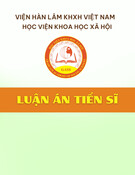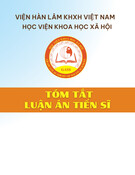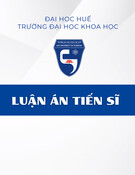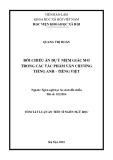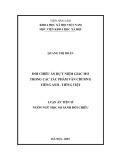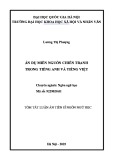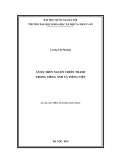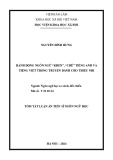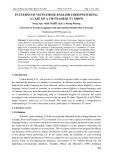MINISTRY OF EDUCATION AND TRAINING HA NOI NATIONAL UNIVERSITY OF EDUCATION ______________________
HO THI KIM ANH AGENTIVES AND OBJECTIVES IN THE MEANING STRUCTURE OF VIETNAMESE SINGLE SENTENCES
Major: Linguistics Code: 9. 22 90. 20
ABSTRACT SUMMARY THESIS WILL BE LANGUAGE
Hanoi – 2019
The work was completed at: Hanoi National University of Education
The scientific instructor: Prof.Dr. Do Viet Hung Reviewer 1: Prof. Dr. Hoang Trong Phien - University of Social Sciences & Humanities - Hanoi National University Reviewer 2: Prof. Dr. Bui Minh Toan - Hanoi National University of Education Reviewer 3: Associate Professor Dr. Vu Thi Thanh Huong - Institute of Linguistics
The dissertation will be defended in front of the School-level Judging Council at Hanoi National University of Education at ... hour ... date ... month ... year ...
The thesis can be found at the library: National Library, Hanoi or Library of Hanoi National University of Education
LIST OF WORKS BY AUTHOR
1. Ho Thi Kim Anh: Role-playing roles in action in "Early period" of Nguyen Binh Phuong (2016), Journal of Science, Hai Phong University, No. 19, pp. 80 - 89. 2. Ho Thi Kim Anh: Determining the action predicate, process predicate by role, object (2018), Proceedings of the National Workshop on Training and retraining of Literature teachers, National University Publishing House, page 230 - 237. 3. Ho Thi Kim Anh: The role of the subject and the object in the multi- meaning phenomenon of the predicate (2018), Proceedings of the International Conference of Linguistics - The development and international integration path, Danang University Publishing House, pp. 13 - 23. 4. Ho Thi Kim Anh: The domination of the opposing role in the transformation of the predicate "actions" to the predicate "positions" (2019), Journal of Language & Life, No. 10 (290), pp. 27 - 32. 5. Ho Thi Kim Anh: Regarding the characteristics of agentives entities in the expressive meaning structure of sentences (2020), Language & Life Magazine, No. 2 (294), p. 16 - 24 (Written together with Nguyen Manh Tien).
INTRODUTION
1. The reason for choosing a topic
Although many researchers have been interested in considering this or other angles, until now, there has been little research on the expression meaning of sentences. In some studies on the syntax and semantics of sentences, there is also confusion of the expressive meaning with the syntactic meaning, the arguments (role) in the structure of the expressive meaning of the sentence with syntactic elements. Particularly, the two objects before and after the predicate are the agentives and the objectives have almost not been taken as the central research objects or if any, the study area also stops at the identification and statistics of small characteristics, type with role is the required value of predicate. Therefore, we choose The agentives and the objectives in the semantic structure of the Vietnamese single sentence as the object of our doctoral thesis with the desire to offer explanations about the grammatical interaction relationship - the semantics of the two objects, the agentives and the objectives in the single sentence in Vietnamese. 2. Research purposes and tasks 2.1. Research purposes
Researching this topic and thesis aims to: - Describe to clarify the characteristics of the agentives and the objectives in relation to the semantic nucleus.
- Indicate the role of the objects agentives and objectives to the realization of the types of things, the realization of the meaning of the predicates in the situation.
With the above results, the dissertation desires to contribute to additionally clarify some theoretical aspects of expressive meaning, agentives and objectives based on Vietnamese evidence; At the same time, provide a useful reference for the study and teaching of Vietnamese grammar. 2.2. Research mission To accomplish the purpose, we set out the research task in the thesis is:
1
- General techniques clarify the research situation related to the topic. - Establish the theoretical basis of the topic by clarifying related concepts. - Describe the characteristics of the agentives and the objectives in the expressive meaning structure of the Vietnamese single sentence. - Clarify the role of the agentives and the objectives in converting Vietnamese predicates from one subcategory to another.
- Clarify the influence of the agentives and objectives on the derivative meanings of the predicate in many Vietnamese single sentences. 3. Object, scope of research and source of materials 3.1. Research subjects The object of the dissertation is two agentives and the objectives in
the semantic structure of Vietnamese single sentence. 3.2. Scope of research and linguistic resources
The research scope of the thesis is the characteristics and the role of the agentives and the objectives in the structure of the expressive meaning of the Vietnamese single sentence with the semantic nucleus which means verbs of action, positions, state, processes.
The source of the thesis is facts determined in: - Vietnamese dictionary (2001), Institute of Linguistics - Center of lexicography, Hoang Phe (chief editor), Danang Publishing House. - Works of short stories and novels printed in a number of
textbooks and story collections. 4. Research Methodology
In order to describe the characteristics of the subjective,
opposing roles and their role in the transformation of predicates, the thesis
mainly uses the descriptive methods:
The method described with the main research tactics:
- Statistical tactics of classification and classification: used to statistic sources (are single sentences with the optimal context including an action predicate, subjective role, opposite object role), and source language classification Data obtained.
2
- Language analysis tactics: used to analyze the characteristics, the role of the subject, object object in the structure of the meaning and expression of sentences. - Modeling tactics: used to describe the semantic valence model of sentence types suitable for microscopic frames. - Conversion tactics: used to change the syntax order of sentence
components to reveal their grammatical - semantic functions. Discourse analysis method: is used to analyze: - Characteristics of types of subjects and objects in love are a single from subjects and in Vietnamese, distinguishing them sentence complements in the syntactic structure.
- Analysis of the role, the influence of the subject, the object to the derivative phenomenon and the transformation of grammatical - semantic characteristics of the nuclear predicate. 5. The meaning and contribution of the thesis 5.1. Theoretically
- As the first work of full and in-depth study of the agentives and the objectives semantics, the research results of the thesis contribute to supplementing and enriching functional grammar theory knowledge about participant and object in the structure of the expression and expression of the sentence on whether a typical single language is Vietnamese.
- The analysis and description of the characteristics of the object object and the object contribute to elucidating one of the interesting and complicated problems in theory as the correlation between the structure of expressive meaning (with the parameters) semantics or roles) with syntactic structure (with syntactic elements). 5.2. On the practical side
The research results of the thesis provide a useful reference, contributing to improving the quality and effectiveness of the Vietnamese language research and teaching. 6. The layout of the thesis In addition to the Introduction, Conclusion, References, Appendix, the thesis content consists of three chapters: Chapter 1: Overview of research situation and theoretical basis
3
Chapter 2: Characteristics of the agentives, the objectives in the structure of
the meaning and expression of Vietnamese single sentences
Chapter 3: The role of the agentives, the objectives in the structure of the
expressive meaning of Vietnamese single sentences
4
CHAPTER 1: OVERVIEW OF RESEARCH SITUATION AND RATIONALE
1.1. Overview of research situation 1.1.1. The situation of research on the expression meaning structure 1.1.1.1. In the world
According to S.C. Dik, the basic distinction between events is expressed on two characteristics with [+] and not [-] between the two dimensions of the dynamic and + active (intentional) opposites. In functional grammar, the entity's + dynamic property is understood to be variable, and the dynamic attribute of the entity is understood to be no change at any time during its existence in love. The + active attribute is a category that includes intent but not heterogeneity, so if intent can be associated with humans, + initiative can be associated with people and animals. In other words, active + character always requires being associated with a conscious subject. Particularly attributes - initiative is a wider category, can be associated with people, animals, real animals. Two standard pairs are divided into three grades:
Tier 1: Apply the standard [± dynamic] [+ Dynamic] events are called Events. The [- dynamic] things are called Situation. Tier 2: Apply the standard [± active] Level 3: Apply the Performance criteria Other than S.C. Dik, author M. Halliday divides all the facts into three worlds (regions):
- The physical world - Human inner world (world of consciousness) - The world of abstract relations M. Halliday uses the term process instead of the predicate term to refer to the structure of the expression meaning of the sentence as the process structure - the greed and confirms “a process of three components:
(i) the process itself (ii) process participants (iii) contexts related to the process
5
These components provide a reference frame to explain our experience of what is happening.” The process is the center of the situation. Participants in the process include: Actor, Carrier, Sayer, Senser, Goal, Recipient, Recipient (Receiver) ), Multilingual Language (Target), Dac Loi (Beneficiary), Vulnerable (Maleficiary), .... Circulations related to the process include: Distance (Distance), Duration (Duration), Location (Place), Time (Time), Media (Means), Quality (Quality), Comparison (Comparision ), Cause, Purpose, Condition, Concession, etc.
The process structure - the physical aspect of M. Halliday includes all four types of events Action, Process, Posture, Status and is shown by the following pie chart. 1.1.1.2. In Vietnam
Advocating according to the concept of M. Halliday, author Diep Quang Ban said that the expressive meaning structure (or transfer structure) is used to perform the expression function of the sentence Thus, the structure of expressive meaning of the sentence including the part indicating things (state characteristics or relationships) and the roles within the scope of that scope. Part things are done by the element and express the characteristics or relationships. The roles are divided into Entities and Situations.
Recognizing the predicate as the center of the expressive meaning structure but having its own concept of the division of roles, author Nguyen Van Hiep said that the expressive meaning structure reflects human perception of the world, there is a core that surrounds the greeds that signify certain roles. Inheriting the deep list of semantic ways of Ch. Fillmore, adding semantic wings by Chafe, Dik, Dixon, Parson and some other authors, uses grammar modification to reveal the syntactic attitude of the syntagm, the author gave numbered 22 roles.
Based on the valence theory of L. Tesnière, author Nguyen Van Loc, in his work "Vietnamese grammar" affirms, participating in organizing the structure of expression meaning is semantic elements including semantic nucleus signifies the core of facts and roles, of which the most important element is the semantic nucleus and the analysis of the expression of meaning must first identify the semantic nucleus.
6
1.1.2. Research situation on the subject and the object 1.1.2.1. In the world
The role of agentives meaning (also known as the semantic agentives in the structure of expressive meaning to distinguish with the subject in the syntactic structure) is accepted by both linguists M. Halliday and S.C. Dik is only exported by 4 meaning functions.
For M. Halliday, he first distinguished between body (base, element) and context (extended, cyclical). Greed is all meaning functions directly related to the situation, directly controlled by the predicate or must be accepted by the predicate. Context is ancillary functions, depending on, adding to the situation elements of circumstances and situations that help the situation to be expanded and more complete. Next, he distinguished the three things the subject was in the sentence and lay at different levels. That is: - Grammatical agentives, often called agentives, is associated with the organization of grammar of sentences.
- The logical agentives is associated with the way of organizing a logical clause if it is present in the sentence, ie associated with the expression meaning of the sentence.
- Psychological agentives associated with the intention of the sentence user in a specific case, ie associated with choosing the starting point for the sentence, related to the text function.
With S.C. Dik, the function of semantic agentives in the structure of expressive meaning is delineated depending on the context of the situation. Semantic agentives include 4 types.
The role of the object (also known as the semantic objects in the structure of the expressive meaning to distinguish with the object in the syntactic structure) signifies the person under the influence of the activity. The object of the objectives is called by M. Halliday and S.C.Dik as Goal. 1.1.2.2. In Vietnam
Cao Xuan Hao said: "Participation in the situation has the argument (Participants) of the situation, including the actors (Actants) and the cycle (Circumstants)" the guys standing around". Elements are indispensable roles presupposed in the meaning of the predicate. With Cao Xuan Hao, the
7
agentives matter is composed of 5 subcategories: Action, Action, Dynamic form, Test, Force.
According to author Diep Quang Ban, the specific meaning function of the roles in the sentence depends on the communication situation of the sentence, how many situations there will be many types of roles and meanings associated with the central predicate. Author Nguyen Van Hiep also gave his opinion. Study the structure of the expression meaning of the sentence, the subjective meaning determined by Nguyen Van Loc based on the specific function in the type of affair it participates in; The opposite role is distinguished from the role of Continuing, Purpose because this role only serves the meaning function in the situation of action. 1.1.2.3. Some studies on subjects and objects in grammar works
Inheriting the results of the study on the expression meaning structure, there have been many studies on the agentives and the objectives. - The author Lam Quang Dong studied the structure of expression expression of the sentence with the predicate group given in the book «Structure of the expression meaning expression of the sentence with the group of predicate groups (in English and Vietnamese)», 2008, Social Sciences Publishing House. - Doctoral dissertation «Spoken from three elements in Vietnamese», 2017 by Do Thi Hien. - Doctoral dissertation «Verb with three elements in Vietnamese
(compared with English)», 2019 by Nguyen Thi Huong. .... 1.2. Basis for argument 1.2.1. Aspects of the three-dimensional theory of sentences in functional grammar 1.2.1.1. Grammatical aspect Is the plane derived from the geometric plane of the signal, studying the relationship between signals and signals. Research issues in grammatical aspect are sentence components, syntactic positions of sentences, and sentence types classified according to grammatical structure. 1.2.1.2. The semantic plane
8
This is the plane that comes from the semantic notion of the signal, studying the meaning content of the sentence.
The meaning of the sentence, in a broad sense, is a combination of two elements: the expressive meaning (descriptive meaning, meaning meaning, propositional meaning, conceptual meaning, empirical meaning) and emotional status (connective meaning) multiply). In a narrow sense (in functional grammar), the meaning of a sentence is its expressive meaning. 1.2.1.3. Pragmatic plane
Is the plane derived from the applied plane of the signal, studying the relationship between the sentence and the sentence user. Pragmatical issues include: conversation rules, linguistic behavior, explicit meaning, implicit meaning, presupposition, old - new information structure, information focus, etc. 1.2.2. Some related concepts 1.2.2.1. Concept of expression
Expression of meaning (meaning of description, meaning of experience, meaning of experience, deep meaning ...), according to the common conception, is understood as a kind of meaning reflecting human perception and experience of the world; in particular, about things, phenomena, properties, their relation in objective reality. This type of meaning, according to M. Halliday, is defined in the structure of the sentence (sentence) as the expression and includes the main concepts such as: process, greed, context as semantic categories of explanatory semantics. most generally the phenomena of the real world. 1.2.2.2. Concept of expressive meaning structure
In this thesis, the concept of the expressive semantic structure of sentences is understood as equivalent to the concept of semantic structure (семантическая структура / semantic structure) which is often mentioned in many foreign language works. For example, according to I.P. Raspopov, "in the majority of semantic-themed studies of sentences, semantic structure is often understood as a generalized structure that unifies a range of different specific syntax structures but reflects same thing (event, thing) ". These are abstract logical schemas (formulas) that are generalized from different structures with the same semantic content. The semantic structure
9
of sentences in this interpretation is often identified with the deep structure (глубинная структура / deep structure). 1.2.2.3. Semantic nucleus concept
In this thesis, the concept of a semantic nucleus is understood based mainly on the ideas of L. Tesnière when he discusses the concept of nuclear (nucléus) as the center of syntax and semantics of sentences. 1.2.2.4. The concept of semantic greed (role meaning)
Do not go into the debate on the issue just mentioned, in this thesis, based primarily on the opinion of S.C. Dik, we understand that semantic greed is a semantic element in the expressive semantic structure of sentences expressed by actual words, undertaking certain semantic functions considered in relation to the semantic nucleus (also are represented by the actual verb, mainly verbs, adjectives). 1.2.2.5. Agentives concept
- Is the basic semantic parameter in the structure of expression meaning of the verb - verb refers to the types of facts: actions (positions), positions (positions), states (states), processes (processes).
- In the basic form, it is represented by the form of words (nouns, noun phrases, pronouns) not connected by dependent relation relations that occupy the position before the nuclear verbs. - Only the actual activist or the logical agentives of the activity. 1.2.2.6. Objectives concept
- Is the basic semantic parameter in the structure of expression meaning of the verb - verb refers to the kind of actions that have externalities and actions.
- In the basic form, represented by the form of words (nouns, noun phrases, pronouns) occupying the position after the nuclear verb (which is real words). - Only those who are affected by the action (only the logical object
of the action). Conclusion of Chapter 1
10
CHAPTER 2. CHARACTERISTICS OF SUBJECTS AND OBJECTS IN THE STRUCTURE OF THE EXEPRESSION OF VIETNAMESE SINGLE SENTENCES 2.1. Introductions
This chapter examines the content characteristics, the form of the agentives, the objectives, identifies the predicate frames with two objects the agentives, the objectives in the structure of the expression and expression of the sentence. In addition, the correspondence between the agentives, the objectives and the subject, the object in the syntactic structure of the sentence is also an issue pointed out in the content of this chapter. 2.2. Characteristics of the subject 2.2.1. General characteristics of the agentives 2.2.1.1. Content characteristics
The appearance of the agentives is required by the meaning of the verb - kernel. The meaning of the agentives always depends on the meaning of the verb - nucleus. The agentives has a strong attachment to the nucleus and is also the most popular means among the participants. The characteristic meaning of the agentives is the activist or the logical (actual agentives) of the activity. 2.1.1.2. Form characteristics a) Basic form of the agentives
In basic form, the agentives is represented by the word form (nouns, noun phrases, pronouns) not connected by the relation of words that occupy the position before the nucleus (verb - verb). b) The non-basic form of the agentives
In its non-basic form, the agentives can occupy the following positions: after the semantic nucleus; between the syntactic kernel (verb - semi-verb) and the semantic nucleus (real verb); between subject - objectives and kernel syntax - semantics; after the nucleus is semantically and is guided by the word relation by. 2.2.2. The basic opposites in the subject category 2.2.2.1. Classification principles
11
Because the relational meaning of the agentives is always determined by the meaning of the nucleus, in order to identify and describe the types of subjects considered in relation to the semantic nucleus, in principle, it is necessary to base on the meaning of the nucleus, nuclear flavor. In some cases, it is necessary to take into account the interaction between the agentives and the objectives and other basic semantic entities that may have the nucleus. 2.2.2.2. Agentives types in terms of relational meaning 1) Acting agentives (action figure) The characteristic action object for the nucleus is the verb for the action.
Small types in the category of action agentives: - Inactive agentives: This type of agentives is typical for non-action verbs (inactive verbs), that is, verbs that act on the agentives but not on objectives (go, run, jump, swim, crawl, rolling, crying, laughing ...). In accordance with the meaning does not work, the verb verb does not require (dominate) the objectives. Thus, the inorganic agentives is the only basic paramedic type with the side of the inactive verb playing a nuclear role, ie, the type of the corpuscle does not correspond to the objectives (It is in It goes. It runs. It laughs.).
- Acting agentives (agent) An entity specific to the action verb (the transposition verb), that is, the action verb that comes from the subject acting on the objectives (eating, reading, writing, hitting, beating, burning, breaking, biting, tear ...). Consistent with the meaning indicated above, the action verb always requires (dominates) the objectives - the objectives affected. This means the entity always corresponds to the objectives. This is an important distinction between an agent and an invisible objectives. Because the objectives always exists with respect to the objectives, the entity has a more complex semantic relationship than the unlicensed objectives. The agentives categories in the body: + Author - the creator of the objectives (creator).
12
Author - the creator of an objectives (called creator) for specific artifact verbs, that is, the verb of action that creates the objectives (writing, drawing, digging, covering, molding, training) , compose, compose, build, ...). (52) It paints this picture. + Authors - who destroy or distort things mentioned in the objectives (53) They burn hundreds of tons of rice.
+ The body of the giver (the one who transfers the ownership of objectives stated in the object) This type of association characterizes the verbs of the act of giving (giving, giving, giving, sending, giving, giving, etc.). (57) An elderly woman gives her five dong a month. + Authors - who collect objectivess stated in an objects This type of association characterizes the verbs of the act of
acquisition (take, rob, snatch, confiscate, confiscate, borrow ..). (59) I borrowed the boat of Xeo Duoc relatives. + Actors - the one who performs the act of making requests
This type of actor is specific to verbs that act to make requests (to arrest, to forbid, to invite, to ask, to ask, to invite, to be wrong, to request ...). (61) The mistress sends her son to carry water. + Actors - those who move objectives This type of actor is specific to verbs that move the object (put, throw, toss, investigate, vent, string, piercing, etc.).
(65) Seeing Animation, he put the flute on his belt. + Actors - those who act create harmony, link between objectives. This type of actor is typical for verbs that combine two objects (tie, mix, attach, connect, etc.) (68) I've attached my whole life to this land. 2) The positions bearer
The person who bears the typical posture for verbs refers to the posture of positions (positions) which are typical: standing, sitting, lying, awake, sleeping ... (72) Male standing in the middle of the school yard. 3) State bearer
13
The person who brings the characteristic state to the verbs indicates the state (states) with two main meanings: - verb and - intentional. These verbs are not very large in number. Typical state verbs are verbs longer (in the sense of being). Also belonging to the state verb group are some verbs that only act but are transformed into the state meaning (as a result of the action: hanging, closing, opening, locking).
(77) Money left. 4) Who goes through the process
The person who undergoes the process (prosesser) is the type of subject specific to the nucleus which is the verb of the process (prosessed). (83) It falls.
2.2.2.3. Types of subjects in terms of self-meaning (vocabulary meaning) a. Agentives with lexical meaning refer to entities + people (97) Contact goes to Mount Mountain. b. Agentives with lexical meaning refer to entities - people
With lexical meaning not only human, subject - person can have lexical meanings indicating animals, plants, natural phenomena (nature, weather), artificial objects (means of transport) , weapons, items) ... (105) Dog barking. c. Agentives with lexical meanings refer to entities in the spiritual category (120) Spring love nights have come.
2.3. Characteristics of the objectives 2.3.1. General characteristics of the objectives 2.3.1.1. Content characteristics
The appearance of the objectives is required by the meaning of the verb - kernel. The meaning of the objectives always depends on the meaning of the verb - nucleus. Like the agentives, the objectives is the basic argument, which is mandatory in the structure of the expression and meaning of the sentence. The common meaning specific to the objectives is that only the person or thing is affected by the action stated in the semantic nucleus. 2.3.1.2. Form characteristics a) Basic form of the objectives
14
In basic form, the objectives expressed by the form of words (nouns, noun phrases, pronouns) occupying the post-nucleus position is the verb - the verb has the passive and the action (eat, read, write, hit, smash, burn, break, give, give, invite, advise, throw, place, mix, match ...). For example: "Nam reads a book.", "Nam writes a letter.", "The soldiers fight the enemy.". b) The non-basic form of the objectives
In its non-basic form, the objectives is located before the semantic nucleus by transforming the position of the object - objectives and by passive transformation. 2.3.2. The basic opposites in the object category 2.3.2.1. Classification principles
Because the relationship meaning of the object is always determined by the meaning of the nucleus, in order to identify and describe the types of objects in relation to the semantic nucleus, in principle, it is necessary to base on the meaning of the nucleus, nuclear flavor. In some cases, it is necessary to take into account the relationship between the object and the subject and other basic semantic entities that may have the nucleus. 2.3.2.2. Objectives types in terms of their relationship 1) Objectives - object produced by an act of artifact (creation)
Creating specific characteristics for the nucleus is the verb for the act of creating (digging, covering, molding, writing, drawing, building, composing, compiling ...)
(133) They dig ditches. 2) Objectives - destroyed object
This type of object specific to the nucleus is the verb of destruction (burning, burning, burning, destroying, killing, destroying, destroying, erasing ...). (139a) Afternoon, Tinh kill an ant nest at the base of the fig. 3) Objectives - object is changed in state and properties
This type of object specific to the nucleus is a verb that acts to change the state and properties of the object (bite, cut, chop, plow, hoe, saw, wipe, smash, san, tear, etc.). (141a) Ms. Dieu ripped her shirt off.
15
4) Objectives - those who are reviewed and evaluated This type of object specific to the nucleus is the verb to comment, evaluate the object (vote, choose, send, consider, call, worship ...). (142) He sees money as an offender. 5) Objectives - object to be transferred ownership
This type of object specific to the nucleus is the verb to give (give, provide, give, give, give, send, give, give, give ...) and receive (borrow, take, receive, rob, seizure, confiscation, borrowing ...) (147) My father gave each person a family 4m of soldier cloth. 6) Entire objectives
This type of objectives specific to the nucleus is a verb that invitation, advice, (arrest, protection, prohibition, requires action invitations, requests, orders, wrong ...). (152) Mrs. Phan invited all the brothers to dinner. 7) Objectives - object displaced
This type of objectives specific to the nucleus is the action verb that moves the object in space (throwing, throwing, placing, hanging, trapping, emptying, stringing, etc.). (156) The mischievous children throw dirt at us. 8) Objectives - connected object, mixed
This type of objectives specific to the nucleus is a verb that acts to blend or connect two things (tie, mix, knead, combine, attach, connect, attach ...). (161) Mix salt and water. 9) Objectives - objects of comparison and comparison This type of objectives specific to the nucleus is a verb that compares, collates (collates, compares, contrasts, equates ...). (163) Articles contrasting Vietnamese with English. 10) Objectives - the scope of cognitive activity
This type of objectives specific to the nucleus is a verb that indicates the awareness of things and phenomena (table, discussion, commentary, research, discussion, exchange, inquiry ...). (165) Meeting to discuss environmental issues. 11) Objectives - the direction of the action
16
This type of objectives specific to the nucleus is a verb that acts only psychologically (attention, attention, attention, attention, attention ...). (168a) He doesn't seem to pay much attention to the story. 12) Objectives - receptor This type of objectives specific to the nucleus is a verb that indicates receptors (listening, watching, watching, ...).
(170) He looks at Rooster's face. 13) The objectives of the mind-controlled action
This type of objectives specific to the nucleus is the verb that controls the control of the object towards the object, which is an inseparable part (shake, nod, aim, blink, blink, glare, crack, crack, tip, etc. .). (174) Brother Ba Hoanh glared up.
2.3.2.2. Objectives types according to their meaning (vocabulary meaning) a. Objectives with lexical meanings refer to entities + people (integral parts of humans) (177) Tinh questioning Mr. Dien. b. Objectives with lexical meanings refer to entities - people (183) I have a cicada in my hand.
c. Objectives with lexical meanings refer to the entity in the spiritual category (194) And I suddenly understood the reservations and thought of
Luu earlier. 2.4.1. A few words about the concept of the predicate frame
In this thesis, absorbing (adjusted in the direction of simplifying the interpretation of the predicate frame of SC Dik), we determined: the predicate frame is a model structure of expression meaning of Vietnamese sentences including predicates. The kernel (which is the real word) and the underlying semantic parameters are defined by the semantic nucleus. 2.4.2. Some common predicate frames with two subject and object arguments
Two objects the agentives and the objectives that can appear in the predicate frame with the nucleus are action predicates, positional predicates, state predicates, and process predicates.
17
2.5. The correspondence between the agentives, the objectives and the subject, object 2.5.1. In case of overlap between the agentives, the objectives and the subject, object (222) The boy puts the water in.
2.5.2. The case does not overlap between the agentives, the objectives and the subject, object (230a) The organizing committee grants the prize to the captain. Conclusion of chapter 2
CHAPTER 3. ROLE OF SUBJECTS AND OBJECTS IN THE STRUCTURE OF THE EXEPRESSION OF VIETNAMESE SINGLE SENTENCES
3.1. Introductions
The nature of the affair is determined by the nuclear predicate and the nuclear role of the predicate determines the presence of the particulars and the content of that affair. However, predicates can have many meanings or be used with new meanings. Then, the definition of the predicate is realized in the predicate - parameter structure will be based on the semantic nature of the parameters. A change in the lexical - grammatical characteristics of a predicate is an intrinsic change of the predicate and that leads to the appearance of different entities governed by the predicate. On the contrary, the semantic nature of the parameters also plays a significant role in determining the situation and when describing and classifying the situation, it is impossible not to take into account the semantic characteristics of the parameters. 3.2. The role specifies derivative meanings for the nuclear predicate 3.2.1. The role concretizes a derivative meaning for the nuclear predicate The predicate concretizes a derivative meaning through the role of the agentives and objectives such as: pressure, press, shoot, dig, pump, handle, plow, stretch, shrink, roll, rob, wipe, cover. , roar, brow, sneeze, draw, howl, butch, print, lure, drive, fill, moi, suck, taste, aim, ngoi, grind,
18
launch, ring, swoop, to, squeeze, sculpt, tap, advance, plucking , dangling, handing, planting, facing, clearing,….
The affinity of nuclear pressure: (247) A girl in her twenties puts her hand on her cheek. (248) Collective dormitories with large pavement. In the situation (247), the agentives of a girl about twenty years old only objectives + person, hand objectives is a part of the agentives who performs the function of holding and holding. Pressure action taken by the agentives. The agentives and objectives in the context explained for the pressure predicate to make the surface of one object close to that of another.
In (248), the meaning adjacent, adjacent is the agentives of the collective area to bring additional pressure. The dormitory is the agentives indicating the objectives - a person, an inanimate objectives, which is incapable of creating the act of oppression as in the situation (247) but describing the derivative oppression of a state of existence. The agentives is located adjacent to the large road facing objectives. 3.2.2. The role specifies many derivative meanings for the nuclear predicate
Entity agentives, objectives can be present and concretize many derivative meanings for the predicate. The predicate concretizes many derivative meanings thanks to their role: fly, crawling, plug, bite, cut, cut, sentence, colander, stamping, erect, go, scream, untangle, unfasten, lower, branda, climb, speak, blink, hug, spin, mix, ring, withdraw, drop, line, back, fold, floss, ...
The taste of flying nuclear flavor: (284) The crows of the towering rice plants outside the yard suddenly fly up in panic.
(285) Fluttering flags. (286) Fencing bullets. (287) Fragrance has evaporated. Bean notes are flying. The affair (284) has the agentives of crows on the towering rice plants on the beach that are sentient animals. The agentives explains the flying predicate means that it moves in the air.
19
Love (285) has a flag objectives - things made of cloth, silk, with certain sizes, shapes, colors, sometimes even with doodles, used as a symbol for a country or a political organization. social ... A predicate, when associated with the agentives - the person (the flag) means moving with the breeze.
Arriving (286), the derivative meaning is the fast movement of the flying predicate indicated by the agentives of the bullet. Bullets are round cubes, made of metal, launched with a gun to damage.
Two perfume objectives, the bean in (287) indicates the objectives - the person who was present to concretize the meaning of the flying predicate into fade away. 3.3. Role specifies grammatical and semantic characteristics for nuclear predicates 3.3.1. Role specifies grammatical characteristics for nuclear predicates 3.3.1.1. The role of the subject and the object in the internal - external transformation for the nuclear predicate.
Called the actionless predicate because the agentives 's movements and movements have no mechanical impact on an objectives. The unconditional action predicate requires only an inaction, the other entities if involved in the affair, taking on the role of cyclical means: Time, Space, Method, Means, ... When controlling the role of an objectives, it also means expanding the complementary element in the syntactic structure, the inactive action verb - the intransitive verb will change the type into the transliteration action - external verb. 3.3.1.2. The role of the agentives and the objectives in the passive - internal transformation for the nuclear predicate.
The predicate of the transfer action will impart its effect to an objectives that receives the impact, altering the objectives physically (transform, form, excavate, move) or alter it, objectives in terms of psychology, inner thinking. In terms of the expressive structure, the transition action predicate requires two actors, the transfer action objectives and the transfer action object. The lexical meaning refers to the different objectives - people or objects + people of the agentives who have a role in transforming the transposition - transitive verb predicate into a non- veritable action verb - intransitive verb.
20
3.3.2. Role specifies semantic characteristics for nuclear predicates 3.3.2.1. The role of the agentives and the objectives in the transformation of + dynamic and + intentional characteristics to + dynamic and - intentional to the nuclear predicate Agentives and objectives with different lexical meanings contribute to the specification of semantic characteristics of nucleus predicate when these predicate witness the transformation from + dynamic and + intentional to + + dynamic and - intentional
(374) I pull the string. (375) I pull my legs. (376) My legs pulled. (377) The fabric shrinked after being washed. The predicates pull and shrink in (374) and (377) will be determined as action or process predicates depending on the objectives because two speech forms share the agentive I .
In (374), pull is a transitive verb because objectives string indicates an objectives - a human, which is grammatically the object component - the objectives receives the impact from the subject. Agentives I by the action pull affects the other thing - the string, I make the string pulled, the string cannot pull by itself. The predicate co has the characteristic + dynamic and + intentional. In (376), predicate pull is a neutral predicate, which can be considered as action predicate or process predicate according to the point of view at agentives and objectives. The agentives of action pull could be either I or legs. Generally, the grammatical subject I is the agentive, which cause an action to objective legs where predicate pull is a transitive predicate and also an action predicate as in speech (375). However, since objectives legs is a part of agentive I and the objectives itself is the agentives of action stated in predicate pull, agentives I only use its mind to control organ legs to perform action pull instead of directly performing it. Predicate pull in speech (376), if somehow pay the attention on objective pull, is an intransitive predicate, which holds the characteristics + dynamic and - intentional. It is legs to pull, not I, and legs are just organ of human body so it does not intentionally create action as I + human. According to author Diep Quang Ban, legs is the agentives (objectives agentives) of action pull and I is defined to be the cause agentives.
21
Considering speech (377), agentives fabric indicates - people objectives and action shrink is not proactively performed by this agentives as in (374), (375); therefore, pull is also the predicate with characteristics + dynamic and - intentional 3.3.2.2. The role of the subject and the object in
the transformation of + dynamic and + intentional to - dynamic and + intentional to the nuclear predicate
A predicate that has the + dynamic and intentional characteristics has been transformed into a dynamic - and + intentional predicate thanks to the role of the agentives objectives, the object with different types of self-meaning.
(392) In the center circle O, we construct an equilateral triangle. (393) The talented poinsettia erectile built the country. The objectives of an equilateral triangle indicates a plane with three equal angles created by a constructing activity of the agentives + the user of a drawing device. The built-in predicate (392) is a predicate with dynamic and intentional + characteristics.
The inner objectives (393) is an abstract noun about the great and solid career achievement. The constructive predicate contains no transition and is characterized by - dynamic and + intentional. 3.3.2.3. The role of the agentives and the objectives in the transformation of + dynamic and + intentional characteristics into - dynamic and - intentional to the nuclear predicate
Continuing to specify the reverse transformation of the predicate, that is, the transition from the verb to the static predicate, in this section, we describe the predicate transformation with the characteristic + dynamic and + intent (predicate action) to a predicate characterized - dynamic and - intentional (state predicate) thanks to the role of two agentives and objectives arguments.
(420) Ms. Bo puts her ear to the eavesdropping wall. (421) Boat dock. (422) Field dwelling houses. In the love situation (420), the adjective has the characteristic + dynamic, + intention of Ms Bo's agentives. In the situation (421) and (422), human-made inferior objectives created boats and houses that
22
eliminated the action characteristics of the pressure predicate and replaced them with the characteristics - dynamic, - owner intentional. Pressure is a state of being in the static form of unconscious agentives due to the influence of two agentives - people. Conclusion of chapter 3 CONCLUSION
1. The results of researching the characteristics of the subject and
the object in the expressive meaning of the sentence not only help to
understand the semantic aspect, the depth structure of the sentence but also
help clarify the most important function of the sentence. particular sayings,
of the language in general: functions that reflect reality.
Inheriting the concept of the expressive meaning, the expressive semantic
structure of the previous linguists, the thesis has built the concept of tools
as the theoretical foundation of the concept of semantic nucleus, semantic
greed.
The subject is the basic semantic parameter in the expressive
structure of the sentence that is specific to the verb - the actual words
indicating the types of facts: actions (positions), positions (states), states
(states), too process, the object is the basic semantic argument in the
expressive structure of the sentence that is specific to the verb - the verb
refers to the type of actions that have externalities and impact.
2. Entity object, object in the expressive meaning structure is
identified through its characteristics in terms of content, form and opposing
aspects. In terms of content, the two subjective objects, the opposites are
closely associated with the semantic nucleus. The appearance of the
subject, the object in the affair is required by the predicate, in which the
subject is the most popular among the arguments, almost always present
next to the nuclear predicate except for love that the subject is as vague as
the slogan, the order in public places. The specific meaning functions of the
subject (the action subject (the action), the process subject (the person who
23
undergoes the process), the posture subject (the person in the posture), the
state subject (the person who carries the state) the state and the object (the
object created (created), the object to be transferred, the object destroyed,
...) are governed by the meaning of the nuclear predicate. specific meaning
in the structure of expression meaning of sentence: Form: subject object,
object with expression, position compared to semantic nucleus and
associated method (ability to be connected by officials). The oppositional
aspects of the subject and the object are expressed in the semantic
relationship with the nucleus in their structure of expressive meaning and
their own meaning.
3. The lexical meaning refers to the entities + people or - people
of the subject, the object can be taken as an element to identify the type of
predicate and the situation. The ability to combine predicates with two
subject and object references in an affective context contributes to the
internal or external grammatical meaning of a predicate. Besides, subject
and object are also entities that can be relied upon to determine the
transformation of the characteristic + dynamic, + intention of the predicate
from action to sub-categories + dynamic, - intentional, - dynamic, +
intentional, - dynamic, - intentional of a semantic nuclear predicate in a
sentence's expressive meaning structure.
4. The affective contexts of the 300 nuclear action predicates
have a transition to expressing the process, posture, and status predicates
also showing the predicate along with the transformation in expressing the
love affair. There is a change in the meaning of vocabulary. When the
predicate requires different object and object entities, it is the subject and
object subject that realizes new derivative meanings in addition to the
original meaning for the predicate. The combination of each subject and the
object with the lexical meaning refers to the objects + people with the
24
predicate in a context of affairs will realize for the predicate one or more
derivative meanings.
5. To express many different meaningful values with only a
single phonetic form, the predicate requires the interaction of the two
arguments required by it. A situation must not only indicate a syntactic
structure but also must perform the expression of a linguistic action, a
certain expression of expression. By saying a sentence, a situation has been
realized. Particularly, the subject can only state the starting point of the
sentence, only the subject can specify the content of the sentence. The basic
syntax structure, the completeness of the Vietnamese sentence corresponds
to the structure of the two-part proposition - The theory makes the sentence
itself become a statement expressing a fact that has shown, both Entity
objects, objects have an important role, affecting the different vocabulary
meanings (in terms of vocabulary - semantics) and the different expressive
meanings (in terms of grammar function) of the predicate.
25

